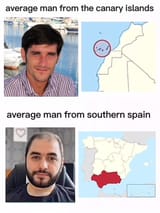Search Results
7/1/2025, 9:15:02 AM
>>509196291
>Fregel et al. 2015 examined the mtDNA of Guanches of La Gomera (Gomeros). 65% of the examined Gomeros were found to be carriers of the maternal haplogroup U6b1a. The Gomero appeared to be descended from the earliest wave of settlers to the Canary Islands. The maternal haplogroups T2c1 and U6c1 may have been introduced in a second wave of colonization affecting the other islands. It was noted that 44% of modern La Gomerans carry U6b1a. It was determined that La Gomerans have the highest amount of Guanche ancestry among modern Canary Islanders
>Ordóñez et al. 2017 examined the remains of a large number of Guanches of El Hierro (Bimbache) buried at Punta Azul, El Hierro (c. 1015–1200 AD). The 16 samples of Y-DNA extracted belonged to the paternal haplogroups E1a (1 sample), E1b1b1a1 (7 samples) and R1b1a2 (R1b-M269) (7 samples). All the extracted samples of mtDNA belonged to the maternal haplogroup H1-1626. The Bimbache were identified as descendants of the first wave of Guanche settlers on the Canary Islands, as they lacked the paternal and maternal lineages identified with the hypothetical second wave
>Rodríguez-Varela et al. 2017 examined the atDNA of 11 Guanches buried at Gran Canaria and Tenerife. The 3 samples of Y-DNA extracted all belonged to the paternal haplogroup E1b1b1b1a1 (E-M183), while the 11 samples of mtDNA extracted belonged to the maternal haplogroups H1cf, H2a, L3b1a (3 samples), T2c12, U6b1a (3 samples), J1c3 and U6b.It was determined that the examined Guanches were genetically similar between the 7th and 11th centuries AD, and that they displayed closest genetic affinity to modern North Africans, "but with a tendency (especially for individuals from Gran Canaria) to occupy a space outside modern Northwest African variation, closer to Europeans." The evidence supported the notion that the Guanches were descended from a Berber-like population who had migrated from mainland North Africa
>Fregel et al. 2015 examined the mtDNA of Guanches of La Gomera (Gomeros). 65% of the examined Gomeros were found to be carriers of the maternal haplogroup U6b1a. The Gomero appeared to be descended from the earliest wave of settlers to the Canary Islands. The maternal haplogroups T2c1 and U6c1 may have been introduced in a second wave of colonization affecting the other islands. It was noted that 44% of modern La Gomerans carry U6b1a. It was determined that La Gomerans have the highest amount of Guanche ancestry among modern Canary Islanders
>Ordóñez et al. 2017 examined the remains of a large number of Guanches of El Hierro (Bimbache) buried at Punta Azul, El Hierro (c. 1015–1200 AD). The 16 samples of Y-DNA extracted belonged to the paternal haplogroups E1a (1 sample), E1b1b1a1 (7 samples) and R1b1a2 (R1b-M269) (7 samples). All the extracted samples of mtDNA belonged to the maternal haplogroup H1-1626. The Bimbache were identified as descendants of the first wave of Guanche settlers on the Canary Islands, as they lacked the paternal and maternal lineages identified with the hypothetical second wave
>Rodríguez-Varela et al. 2017 examined the atDNA of 11 Guanches buried at Gran Canaria and Tenerife. The 3 samples of Y-DNA extracted all belonged to the paternal haplogroup E1b1b1b1a1 (E-M183), while the 11 samples of mtDNA extracted belonged to the maternal haplogroups H1cf, H2a, L3b1a (3 samples), T2c12, U6b1a (3 samples), J1c3 and U6b.It was determined that the examined Guanches were genetically similar between the 7th and 11th centuries AD, and that they displayed closest genetic affinity to modern North Africans, "but with a tendency (especially for individuals from Gran Canaria) to occupy a space outside modern Northwest African variation, closer to Europeans." The evidence supported the notion that the Guanches were descended from a Berber-like population who had migrated from mainland North Africa
Page 1
